Stories about children partisans. Little heroes of the Great Patriotic War: they were not yet sixteen
During the Great Patriotic War When enemies seized their homeland, they began to establish their own rules, dictate how to live, kill, rob, burn their homes, take them captive to a foreign land, all as one stood up to defend their country.
There were a lot of children among those who defended the Motherland.
Here are their names:
Lenya Golikov , Kostya Kravchuk , Valya Kotik , Nadya Bogdanova , Viktor Khomenko , Nina Kukoverova , Vasily Korobko
Alexander Borodulin, Volodya Dubinin , Yuta Bondarovskaya, Galya Komleva , Sasha Kovalev , Marat Kazei
Zina Portnova, Lucy Gerasimenko, Lara Mikheenko
and many others.
Lenya Golikov

He grew up as an ordinary village boy. When the German invaders occupied his native village of Lukino, in Leningrad region, Lenya collected several rifles at the battlefields, got two bags of grenades from the Nazis to hand them over to the partisans. And he himself remained in the partisan detachment. Fought on an equal footing with adults. On August 15, 1942, a young partisan blew up a German car carrying an important Nazi general. The briefcase contained military documents. They were urgently sent to Moscow. After some time, a radiogram came from Moscow, it said that it was necessary to present to the the highest award all those who captured such important documents. In Moscow, of course, they did not know that they were captured by one Lenya Golikov, who was only fourteen years old. So the pioneer Lenya Golikov became a hero Soviet Union.
Kostya Kravchuk

On June 11, 1944, units leaving for the front lined up on the central square of Kiev. And before this battle formation, they read the Decree of the Presidium of the Supreme Soviet of the USSR on awarding the pioneer Kostya Kravchuk with the Order of the Red Banner for saving and preserving two combat banners of rifle regiments during the occupation of the city of Kiev ... Retreating from Kiev, two wounded soldiers entrusted Kostya with banners. And Kostya promised to keep them. At first I buried it in the garden under a pear tree: it was thought that ours would soon return. But the war dragged on, and, having dug up the banners, Kostya kept them in a barn until he remembered an old, abandoned well outside the city, near the Dnieper. Wrapping his priceless treasure in sacking, covering it with straw, at dawn he got out of the house and with a canvas bag over his shoulder led a cow to a distant forest. And there, looking around, he hid the bundle in the well, covered it with branches, dry grass, turf ... And throughout the long occupation, the pioneer carried his difficult guard at the banner, although he fell into a round-up, and even fled from the train in which the people of Kiev were driven to Germany . When Kiev was liberated, Kostya, in a white shirt with a red tie, came to the military commandant of the city and unfurled the banners in front of the seen and yet amazed soldiers. On June 11, 1944, the newly formed units that went to the front were handed the banners saved by Kostya.
Valya Kotik
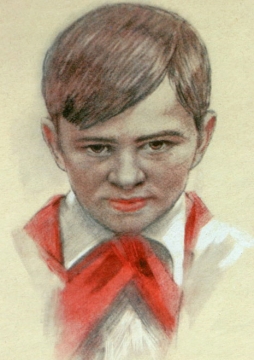
He was born on February 11, 1930 in the village of Khmelevka, Shepetovsky district, Khmelnitsky region. He studied at school number 4 in the city of Shepetovka, was a recognized leader of the pioneers, his peers. When the Nazis broke into Shepetovka, Valya Kotik and his friends decided to fight the enemy. The guys collected weapons at the battlefield, which the partisans then transported to the detachment in a wagon of hay. Having looked closely at the boy, the communists entrusted Valya to be a liaison and intelligence officer of their underground organization. He learned the location of enemy posts, the order of the changing of the guard. The Nazis planned a punitive operation against the partisans, and Valya, having tracked down the Nazi officer who led the punishers, killed him ... When arrests began in the city, Valya, together with his mother and brother Viktor, went to the partisans. The pioneer, who had just turned fourteen years old, fought shoulder to shoulder with adults, liberating his native land. On his account - six enemy echelons blown up on the way to the front. Valya Kotik was awarded the Order of the Patriotic War, 1st class, and the medal "Partisan of the Patriotic War," 2nd class. Valya Kotik died as a hero, and the Motherland posthumously awarded him the title of Hero of the Soviet Union. In front of the school where this brave pioneer studied, a monument was erected to him.
Nadia Bogdanova

She was executed twice by the Nazis, and fighting friends for many years considered Nadya dead. She even erected a monument. It's hard to believe, but when she became a scout in the partisan detachment of `Uncle Vanya` Dyachkov, she was not yet ten years old. Small, thin, she, pretending to be a beggar, wandered among the Nazis. Everything, noticing, everything, remembering, brought the most valuable information to the detachment. And then, together with partisan fighters, she blew up the fascist headquarters, derailed a train with military equipment, and mined objects.
The first time she was captured when, together with Vanya Zvontsov, she hung out a red flag on November 7, 1941 in Vitebsk, occupied by the enemy. They were seized, beaten with ramrods, tortured, and when they brought them to the ditch to shoot, she no longer had any strength left - she fell into the ditch, for a moment, ahead of the bullet. Vanya died, and the partisans found Nadya alive in the ditch...
The second time she was captured at the end of the 43rd. And again torture: they poured ice water over her in the cold, burned a five-pointed star on her back. Considering the scout dead, the Nazis, when the partisans attacked Karasevo, abandoned her. Came out of her, paralyzed and almost blind, the locals. After the war in Odessa, Academician V.P. Filatov restored Nadia's sight.
15 years later, she heard on the radio how the head of intelligence of the 6th detachment Slesarenko - her commander - said that the soldiers of their dead comrades would never forget, and named Nadya Bogdanova among them, who saved his life, wounded ...
Only then did she show up, only then did people learn about what an amazing fate she was, Nadia Bogdanova, who was awarded the Order of the Red Banner, the Order of the Patriotic War of the 1st degree, and medals.
Viktor Khomenko
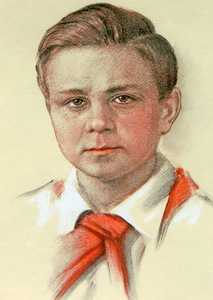
Pioneer Vitya Khomenko passed his heroic path of struggle against the fascists in the underground organization "Nikolaev Center". ... At school in German, Vitya was "excellent", and the underground instructed the pioneer to get a job in the officer's canteen. He washed dishes, sometimes served the officers in the hall and listened to their conversations. In drunken arguments, the fascists blurted out information that was of great interest to the "Nikolaev Center". The officers began to send the quick, smart boy on errands, and soon made him a messenger at the headquarters. It could not have occurred to them that the most secret packages were the first to be read by the underground workers at the turnout ... Together with Shura Kober, Vitya received the task to cross the front line in order to establish contact with Moscow. In Moscow, at the headquarters of the partisan movement, they reported on the situation and told about what they had observed on the way. Returning to Nikolaev, the guys delivered a radio transmitter, explosives, and weapons to the underground workers. Again, fighting without fear or hesitation. On December 5, 1942, ten underground workers were captured by the Nazis and executed. Among them are two boys - Shura Kober and Vitya Khomenko. They lived as heroes and died as heroes. The Order of the Patriotic War of the 1st degree - posthumously - was awarded by the Motherland to her fearless son. The name of Vitya Khomenko is the school where he studied.
Nina Kukoverova
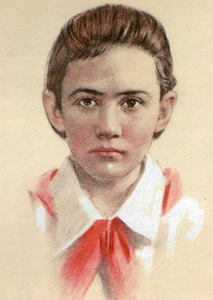
Every summer, mother took Nina and her younger brother and sister from Leningrad to the village of Nechepert, where there is clean air, soft grass, where honey and fresh milk ... Roar, explosions, flames and smoke hit this quiet region in the fourteenth summer of the pioneer Nina Kukoverova . War! From the first days of the arrival of the Nazis, Nina became a partisan intelligence officer. Everything that she saw around, she remembered, reported to the detachment. A punitive detachment is located in the village of Gory, all approaches are blocked, even the most experienced scouts cannot get through. Nina volunteered to go. She walked a dozen and a half kilometers on a snow-covered plain, a field. The Nazis did not pay attention to the chilled, tired girl with a bag, and nothing escaped her attention - neither the headquarters, nor the fuel depot, nor the location of the sentries. And when at night the partisan detachment set out on a campaign, Nina walked next to the commander as a scout, as a guide. Fascist warehouses flew into the air that night, the headquarters flared up, punishers fell, struck down by furious fire. More than once, Nina, a pioneer, was awarded the medal “Partisan of the Patriotic War”, I degree, on combat missions. The young heroine is dead. But the memory of the daughter of Russia is alive. She was posthumously awarded the Order of the Patriotic War, 1st class. Nina Kukoverova is forever enrolled in her pioneer team.
Vasily Korobko
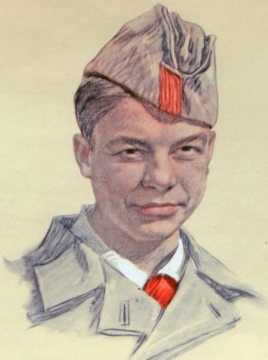
Chernihiv region. The front came close to the village of Pogoreltsy. On the outskirts, covering the retreat of our units, the company held the defense. The boy brought the cartridges to the fighters. His name was Vasya Korobko. Night. Vasya sneaks up to the school building occupied by the Nazis. He sneaks into the pioneer room, takes out the pioneer banner and hides it securely. Outskirts of the village. Under the bridge - Vasya. He pulls out the iron brackets, saws the piles, and at dawn from the shelter he watches the bridge collapse under the weight of the fascist armored personnel carrier. The partisans were convinced that Vasya could be trusted, and they entrusted him with a serious task: to become a scout in the enemy's lair. At the headquarters of the Nazis, he heats stoves, chop wood, and he looks closely, remembers, and transmits information to the partisans. The punishers, who planned to exterminate the partisans, forced the boy to lead them into the forest. But Vasya led the Nazis to an ambush of the police. The Nazis, mistaking them for partisans in the dark, opened furious fire, killed all the policemen and themselves suffered heavy losses. Together with the partisans, Vasya destroyed nine echelons, hundreds of Nazis. In one of the battles, he was hit by an enemy bullet. His little hero, who lived a short but such a bright life, the Motherland awarded the Orders of Lenin, the Red Banner, the Order of the Patriotic War of the 1st degree, the medal "Partisan of the Patriotic War" of the 1st degree.
Alexander Borodulin

There was a war. Above the village where Sasha lived, enemy bombers hooted angrily. native land trampled the enemy's boot. Sasha Borodulin, a pioneer with the warm heart of a young Leninist, could not put up with this. He decided to fight the Nazis. Got a rifle. Having killed a fascist motorcyclist, he took the first military trophy - a real German machine gun. Day after day he fought his unequal battle. And then he met the partisans. Sasha became a full-fledged fighter of the detachment. Together with the partisans, he went on reconnaissance. More than once he went on the most dangerous missions. Many destroyed enemy vehicles and soldiers were on his account. For the performance of dangerous tasks, for the courage, resourcefulness and courage shown, Sasha Borodulin was awarded the Order of the Red Banner in the winter of 1941. Punishers tracked down the partisans. For three days the detachment left them, twice escaped from the encirclement, but the enemy ring closed again. Then the commander called in volunteers to cover the retreat of the detachment. Sasha stepped forward first. Five took the fight. One by one they died. Sasha was left alone. It was still possible to retreat - the forest was nearby, but every minute that delayed the enemy was so dear to the detachment, and Sasha fought to the end. He, allowing the Nazis to close a ring around him, grabbed a grenade and blew them up and himself.
Volodya Dubinin
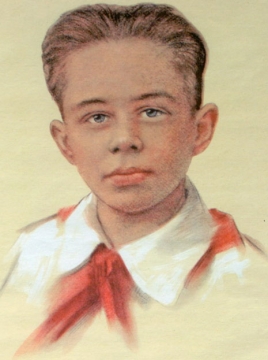
Vladimir Dubinin was born on August 29, 1927. The boy spent all his childhood in Kerch. His father was a hereditary sailor, in 1919 as part of partisan detachment fought with the whites.
The boy was only fourteen years old when the Patriotic War broke out. His father volunteered for the Navy, and Volodya stayed with his mother in Kerch. During the first months of the war fascist troops already approached Kerch. The inhabitants of the city were actively preparing for the underground struggle. With the capture of Kerch, the partisans went to the Starokarantinsky underground quarries near the city. Already on November 7, 1941, an underground partisan fortress appeared in the deep bowels. It was from here that the people's avengers made their bold attacks.
The persistent and courageous boy made sure that he was accepted into the partisans. The young scout operated in the Kletsky and Serafimovsky regions. The partisans loved Volodya, for them he was a common son. With his friends Tolya Kovalev and Vanya Gritsenko, Volodya Dubinin went to intelligence. Young scouts delivered valuable information about the location of enemy units, about the number German troops etc. The partisans, relying on these data, planned their combat operations. In December 1941, intelligence helped the detachment to give a worthy rebuff to the punishers. In the galleries during the battle, Volodya Dubinin brought ammunition to the soldiers, and then replaced a seriously wounded soldier. Legends were told about the guy: how he led a detachment of fascists who were looking for partisans by the nose; how he knew how to slip unnoticed past enemy posts; as he could accurately remember the number of several Nazi units that were located in different places, Volodya was small in stature, so he could get out through very narrow manholes. Thanks to Volodya's data Soviet artillery suppressed the points of the German division, which rushed to Stalingrad. For this he was awarded the Order of the Red Star.
The Nazis tried to destroy the partisans: they walled up and mined all the entrances to the quarry. In these terrible days, Volodya Dubinin showed great courage and resourcefulness. The boy organized a group of young pioneer scouts. The guys got out through secret passages to the surface and collected the information necessary for the partisans. Once Volodya learned that the Germans decided to flood the quarries with water. The partisans managed to build dams out of stone.
The boy knew the location of absolutely all exits to the surface. When Kerch was liberated in January 1942, and the sappers began to clear the area around the quarries, Volodya volunteered to help them. On January 4, a young partisan, helping a sapper, died himself, blown up by a German mine.
The boy was buried in a partisan mass grave, not far from the same quarries.
Yuta Bondarovskaya

The war caught Yuta on vacation with her grandmother. Yesterday she was playing carelessly with her friends, and today circumstances have demanded that she take up arms. Yuta was a liaison, and then a scout in a partisan detachment that operated in the Pskov region. Disguised as a beggar boy, the fragile girl wandered around the enemy rear, memorizing the location of military equipment, guard posts, headquarters, communication centers. Adults would never be able to deceive the enemy's vigilance so cleverly. In 1944, in a battle near the Estonian farm, Yuta Bondarovskaya died a heroic death along with her older comrades. Utah was posthumously awarded the Order of the Patriotic War, 1st Class, and the Partisan of the Patriotic War, 1st Class.
Galya Komleva

In the Luga district of the Leningrad region, the memory of the brave young partisan Gali Komleva is honored. She, like many of her peers during the war years, was a scout, supplied the partisans with important information. The Nazis tracked down Komleva, grabbed her, threw her into a cell. Two months of continuous interrogations, beatings, bullying. Gali was required to give the names of partisan liaisons. But the torture did not break the girl, she did not utter a word. Galya Komleva was mercilessly shot. She was posthumously awarded the Order of the Patriotic War, 1st class.
Sasha Kovalev

He was a graduate of the Solovetsky Jung School. Sasha Kovalev received his first order - the Order of the Red Star - for the fact that the engines of his torpedo boat No. 209 Northern Fleet never failed during 20 combat sorties at sea. The second award, posthumous, - the Order of the Patriotic War of the 1st degree - was awarded to the young sailor for a feat that an adult has the right to be proud of. This was in May 1944. Attacking a fascist transport ship, Kovalev's boat received a collector hole from a shell fragment. Boiling water was pouring out of the torn casing, the engine could stall at any minute. Then Kovalev closed the hole with his body. Other sailors arrived to help him, the boat kept moving. But Sasha died. He was 15 years old.
Marat Kazei

When the war hit the Belarusian land, the Nazis broke into the village where Marat lived with his mother, Anna Alexandrovna Kazya. In the fall, Marat no longer had to go to school in the fifth grade. The Nazis turned the school building into their barracks. The enemy was furious. Anna Alexandrovna Kazei was captured for her connection with the partisans, and soon Marat found out that his mother had been hanged in Minsk. The boy's heart was filled with anger and hatred for the enemy. Together with his sister, a Komsomol member Ada, pioneer Marat Kazei went to the partisans in the Stankovsky forest.
He became a scout at the headquarters of the partisan brigade. Penetrated into enemy garrisons and delivered valuable information to the command. Using these data, the partisans developed a daring operation and defeated the fascist garrison in the city of Dzerzhinsk ... Marat participated in the battles and invariably showed courage, fearlessness, along with experienced demolition workers, mined the railway. Marat died in battle. He fought to the last bullet, and when he had only one grenade left, he let the enemies get closer and blew them up ... and himself. For courage and bravery pioneer Marat Kazei was awarded the title of Hero of the Soviet Union. A monument to the young hero was erected in the city of Minsk.

The authors are sculptor S. Selikhanov, architect
V. Volchek. The monument depicts last Stand hero.
In one hand, Marat is still holding an already useless machine gun, in which there are no more cartridges left, the other has already been raised above his head, bringing for the last throw at the hated fascists approaching him.
In Soviet times, the monument was very famous.
Near it, they were accepted as pioneers, solemn rulers were held, wreaths and flowers were laid, and inspired poems were read.
Zina Portnova

The war found the Leningrad pioneer Zina Portnova in the village of Zuya, where she came for the holidays - this is not far from the Obol station in the Vitebsk region. In Obol, an underground Komsomol youth organization `Young Avengers` was created, and Zina was elected a member of its committee. She participated in daring operations against the enemy, in sabotage, distributed leaflets, conducted reconnaissance on the instructions of the partisan detachment ... It was December 1943. Zina was returning from a mission. In the village of Mostishche, a traitor betrayed her. The Nazis seized the young partisan and tortured her. The answer to the enemy was Zina's silence, her contempt and hatred, her determination to fight to the end. During one of the interrogations, choosing the moment, Zina grabbed a pistol from the table and fired at the Gestapo at point-blank range. The officer who ran into the shot was also killed on the spot. Zina tried to escape, but the Nazis overtook her... The brave young pioneer was brutally tortured, but until the last minute she remained steadfast, courageous, unbending. And the Motherland posthumously noted her feat with her highest title - the title of Hero of the Soviet Union.
Lucy Gerasimenko

She did not derail enemy fuel tanks, did not shoot at the Nazis. She was still small. Her name was Lucy Gerasimenko. But everything she did brought closer the day of our victory over the fascist invaders .. Lusya became indispensable assistant underground. She carried out various assignments: either she took leaflets or medicines to a conditional place, then she handed over reports, then she pasted leaflets on fence posts, walls of houses. Everything is simple and complex at the same time. One careless step and death. Expect no mercy from the Nazis Once in October, they whispered: in the central square, the Germans hanged partisans. One is just a boy. It was Vodya Shcherbatsevich. He was hanged along with his mother, she treated prisoners of war, and then, together with her son, transported them to the partisans. Issued by a traitor. Lucy was cautious, resourceful, courageous. So it went day after day, until the provocateur betrayed their family to the Germans. It happened on December 26, 1942. An eleven-year-old girl was shot by the Nazis.
Lara Mikheenko

For the operation of reconnaissance and explosion of the railway bridge across the Drissa River, after the war, a Leningrad schoolgirl Larisa Mikheenko was presented with a government award. But the Motherland could not present the award to her brave daughter: in the Decree on awarding Larisa with the Order of the Patriotic War of the 1st degree there is a bitter word: `Posthumously`...
The war cut off the girl from her hometown: in the summer she went on vacation to her uncle in the Pustoshkinsky district of the Pskov region, but she could not return - the Nazis occupied the village. Lara's uncle agreed to serve the occupying authorities, and was appointed local headman. His old mother and pioneer niece, who condemned him for this, were evicted from his uncle's house and sent to live in a bathhouse.
The pioneer dreamed of breaking out of Hitler's slavery, making her way to her own. Together with a friend, they decided to go to the local partisan detachment.
At the headquarters of the 6th Kalinin brigade, the commander, Major P. V. Ryndin, at first refused to accept `so small`: well, what kind of partisans are they!
But how much even its very young citizens can do for the Motherland! The girls were able to do what strong men could not. Dressed in rags, Lara walked around the villages, finding out where and how the guns were located, sentries were placed, which German cars were moving along the highway, what kind of trains and with what cargo they came to the Pustoshka station. She also participated in military operations.
At the beginning of November 1943, Larisa and two other partisans went on reconnaissance to the village of Ignatovo and stopped at the house of a trusted person. Larisa remained outside for observation. Enemies suddenly appeared (as it turned out later, one of the local residents handed over the partisan turnout). Larisa managed to warn the men inside, but was captured. In the ensuing unequal battle, both partisans were killed. Larisa was brought to the hut for interrogation. Lara had a hand-held fragmentation grenade in her coat, which she decided to use. However, the grenade thrown by the girl did not explode...
On November 4, 1943, Larisa Dorofeevna Mikheenko, after interrogation, accompanied by torture and humiliation, was shot.
During the Great Patriotic War, more than 3,500 front-line soldiers under the age of 16 served in the Red Army. They were called "sons of the regiment", although there were daughters among them. About the fate of some of them - in our material.
The data of the Central Archive of the Ministry of Defense of Russia on the number of sons of the regiment during the war years are obviously not entirely correct. Firstly, the number indicated by them does not include children participating in partisan detachments and the underground (only in occupied Belarus, almost 74.5 thousand boys and girls, boys and girls fought in partisan detachments); secondly, commanders often tried to hide the presence of a child in the unit. At the same time, the tradition of "sons of the regiment" dates back to the 18th century, when every military unit in Russia had at least one young drummer or midshipman - in the navy.
With the beginning of the Great Patriotic War, children again began to join the army. There were several ways to get into the regular units of the Red Army: the soldiers picked up orphans and children lost during the fighting; the children themselves ran away to the front, and if they managed to reach the front line, the commanders had no choice but to accept them; it was not uncommon for commanders to take their children with them, believing that it would be safer for them. Of course, the unit commander had to hide the appearance of a child in the unit entrusted to him, but it also happened that young soldiers were officially put on allowance - the "son of the regiment" received uniforms, and sometimes personal weapons. Usually they were protected and entrusted to different chores, but sometimes they became full participants in military operations.
Volodya Tarnovsky
The photograph of a boy signing an autograph on the wall of the Reichstag has long been a historical relic. This is 15-year-old Volodya Tarnovsky, who got into the army in 1943, when Soviet troops liberated his native Slavyansk. The chairman of the village council told the captain about the boy rifle brigade, and he invited Volodya to join the army. As the young intelligence officer himself admitted, he literally caught fire with this idea - he wanted to avenge his mother, his dead stepfather and younger brother, who was taken away from the Donbass and whom Vladimir could not find after the war.
At first he was an ordinary messenger, but soon began to go on combat missions with his senior comrades. The soldiers treated the boy with paternal love, altered his uniform and even straightened his boots.
Volodya Tarnovsky received his first award for crossing the Dnieper and rescuing an officer. But even earlier, when he led the lost "Studebakers" with fuel and food directly to the front line, he was presented for an award, but then the political officer decided that it was not good to distribute awards to orderlies and advised him to transfer the boy to scouts. So at the age of 14, Volodya Tarnovsky became a scout. Corporal Tarnovsky already received the medal "For Courage" after capturing the "tongue": when Volodya led the captured non-commissioned officer to the location of his unit, the soldiers passing by could not help but smile - is it a thing seen, a two-meter big man is escorted by a child ?! However, the little escort was not at all laughing - he walked all the way with a cocked machine gun.
And then there was Berlin and the famous autograph on the Reichstag. Then he signed for himself and his comrades.
After the war, Vladimir Tarnovsky graduated from school with a gold medal, and then the Odessa Institute of Engineers navy. According to the distribution, he left for Riga, where he worked at the Riga Shipyard, was its director. And after retiring, Vladimir Vladimirovich was actively involved in social activities, was the Deputy Chairman of the Latvian Wrestling Association anti-Hitler coalition. He passed away in February 2013.
Serezha Aleshkov (Aleshkin)
One of the youngest fighters of the Red Army during the war years was Seryozha Aleshkov. At the age of six, he lost his mother and older brother - the Nazis executed them for their connection with the partisans. The family then lived in the village of Gryn in Kaluga region, which the partisans used as a base. In the summer of 1942, Gryn was attacked by punishers, the partisans hurriedly left for the forests. Little Seryozha stumbled and got tangled in the bushes during one of the runs. It is not known how long the child wandered through the forest, eating berries, when he was discovered by scouts from the 154th rifle, later renamed the 142nd guards regiment. Major Mikhail Vorobyov took the exhausted boy with him and became the second father for the boy. Later, he officially adopted Seryozha.
The boy in the regiment fell in love, dressed, shod - find boots of the 30th size in active army- not an easy task! Due to his age, Seryozha could not take part in military operations, but he tried to help his older comrades as best he could: he brought food, brought shells, cartridges, and in between battles he sang songs, read poetry, delivered mail. And it was thanks to Serezha that Major Vorobyov found his happiness - nurse Nina. 
Together with the 142nd Guards Regiment, Seryozha went through a glorious military path, participated in the defense of Stalingrad, and reached Poland. And once he saved the life of his commander and, concurrently, named father. During a fascist raid, a bomb hit the dugout of the regiment commander, and the explosion blocked the exit. The boy first tried to dismantle the blockage on his own, and realizing that he could not cope, under the ongoing bombing, he ran for help. For this feat, he was awarded the medal "For Military Merit" and a combat trophy pistol. While the soldiers dismantled the logs and pulled out their commander, Seryozha stood nearby and, as it should be for a child, sobbed ...
And somehow, already on the Dnieper, an observant boy noticed two men in a stack of straw and immediately reported this to the command. So we managed to grab two Germans with a walkie-talkie, who made their way to the rear to correct the artillery fire ...
During the time spent at the front, Seryozha was wounded several times, shell-shocked, which did not prevent him from entering the Tula Suvorov military school. Later he studied as a lawyer in Kharkov, after graduation he left for Chelyabinsk, where he lived adoptive parents. Worked as a prosecutor. In 1990, the youngest soldier of the Red Army died - severe injuries affected.
Arkady Kamanin
The son of a Soviet officer, pilot and future Hero of the Soviet Union, Nikolai Kamanin, ended up in a military unit due to his stubbornness. In February 1943, his father was appointed commander of one of the attack air corps. Kalinin Front, and together with him his wife and son moved to the location of the unit. 14-year-old Arkady immediately began working as an aircraft mechanic - the boy was interested in airplanes from childhood, and he managed to work as a mechanic at a Moscow aircraft factory and at one of the airfields. The father tried to send the child to the rear, but he stubbornly declared: "I won't go!" I had to give in, especially since the front needed qualified mechanics. 
Very soon, the younger Kamanin began to learn to fly and took to the skies in a two-seat training U-2 as a navigator-observer and flight mechanic. Already in July 1943, General Kamanin personally presented the 14-year-old Arkady with an official permit for independent flights. "Flyer" - that's what the squadron called Kamanin Jr. - along with adult pilots, they had to risk their lives daily, performing command tasks. But the youngest pilot of the Great Patriotic War was distinguished by fearlessness. On one of the sorties, he saw a wrecked IL-2, the cabin of which was buried in the ground. The plane lay in no man's land, and Arkady immediately rushed to the aid of the wounded pilot. Having loaded a Soviet officer and photographic equipment into his U-2, the "flyer" managed to reach his headquarters unscathed. For this feat, he was first awarded the Order of the Red Star. In early 1945, Arkady Kamanin delivered a secret package to a partisan detachment by flying behind the front line along an unexplored route in mountainous terrain. For two years of service he received six awards, including the Order of the Red Banner, as well as medals for the capture of Budapest, Vienna and the victory over Germany.
After the end of the war, like many sons of the regiment, Arkady had to return to school in order to receive a certificate of school education- It took him only one school year to catch up with his peers academically. In October 1946, Sergeant Major Kamanin entered a preparatory course at the Zhukovsky Air Force Academy. A year later, the youngest pilot of the Great Patriotic War suddenly died of meningitis.
Valery Lyalin
In the navy, the sons of the regiment were called cabin boys. Most often they were the children of dead sailors. Valery, or as he was called Valka, Lyalin entered the fleet in the spring of 1943. By this time, his father, the commander, died at the front, and his mother, who worked at the factory, died under the bombing, he wandered around the Batumi port and, accidentally meeting the captain torpedo boat TKA-93 Lieutenant Andrey Chertsov, asked him to take him on the ship. “I remembered my childhood, how I was a homeless child, I feel: my throat is tickled. It’s a pity for the boy,” Chertsov recalled. After conferring with the mechanic, they decided to take the child with them and, if necessary, arrange a cabin boy at the school. No one could have imagined that in a few months he would become a full member of the crew, master the motor business and control the boat.
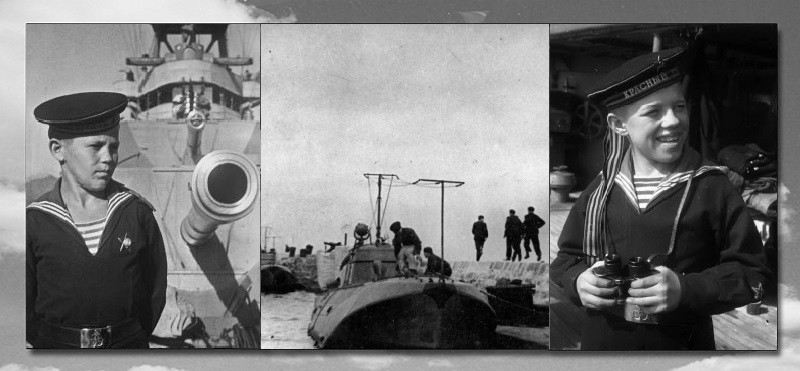
Valka accomplished his feat in September 1943, when the Black Sea sailors were instructed to free the port of Novorossiysk from the bonnet barrier. Realizing the danger of the assignment, Lieutenant Chertsov categorically forbade the cabin boy to participate in the operation. On the night of September 11, under heavy fire from the Nazis, the boat approached the intended place, landed the paratroopers, then in Gelendzhik took on board another 25 paratroopers and new ammunition and again set off for the port of Novorossiysk. It was already dawn, the Germans pulled up artillery and mortars to the port, but Chertsov decided to break through a solid wall of fire. Already on the approach to the berths, fragments of a shell fell into the oil pipeline of one of the engines. While the cabin boy Lyalin - and he slipped on board when the boat was picking up the second group of paratroopers - was repairing one engine, the second one also stalled. Shells burst near the side, most of The team was killed, and the captain was wounded. There was practically no hope of salvation, when suddenly Valka reported that he had repaired the right engine. Having landed the paratroopers, the boat, half-flooded from the holes received, went to Return trip. When Chertsov, having lost consciousness, released the helm, cabin boy Lyalin took his place in the wheelhouse. To see the windshield, he had to stand on the box, and the steering wheel had to be rotated, leaning on it with his whole body. Overcoming fatigue and pain in his hands, the cabin boy brought the boat to the cape, behind which was the entrance to the Gelendzhik Bay.
Later, Chertsov still got Valka Lyalin to the Tbilisi Nakhimov School. According to the recollections of his classmates, he was the only pupil who had four combat medals on his chest. Later, Valka also received the Order of the Red Star, but the title of Hero, which Lieutenant Chertsov petitioned for, was never awarded to him - the division commander was afraid of being demoted because, in violation of all rules and instructions, an underage teenager serves on the ship.
With the names of Valka Lyalin and captain Andrey Chertsov, another one is connected. amazing story. After that terrible campaign, all the surviving crew members were treated in a hospital near Novorossiysk. Once Klavdia Shulzhenko came to the wounded with a concert. And when the performance ended, Klavdia Ivanovna saw that one of the sailors was pulling his bandaged hands towards her. She did not understand what the wounded man wanted to say. But then the cabin boy ran up and explained that the commander asked to perform his favorite song "Hands". Many years later, in the mid-1970s, the TKA-93 crew met again with great singer, and it happened on the set of "Blue Light". According to Shulzhenko’s memoirs, in a group of men at one of the tables, she recognized both the matured Valery Lyalin, and the gray-haired Andrei Chertsov, on whose chest the star of the Hero of the Soviet Union flaunted, and other crew members who happened to survive that terrible campaign. The singer again performed "Hands".
In November 1943, an order was issued to enroll all the sons of the regiments in the Suvorov and Nakhimov schools. However, the boys at that moment wanted to reach Berlin more than to sit at the school desk. This happened, for example, with Tolya Ryabkov. soldiers artillery regiment they literally saved him from starvation in besieged Leningrad - they assigned the little soldier first to the kitchen, then to the signal detachment, and in February 1942, the 13-year-old boy took the oath. A year later, Tolik was sent to Suvorov School However, he did not want to stay there and returned home. IN regular school the boy also survived only a couple of weeks, and then fled to Kronstadt.
1941 -1945 Children - heroes of the Great Patriotic War Kakhanovich Nikita, Zhigadlo Ivan, 6 B MBOU class"Dedovichskaya secondary school No. 2"
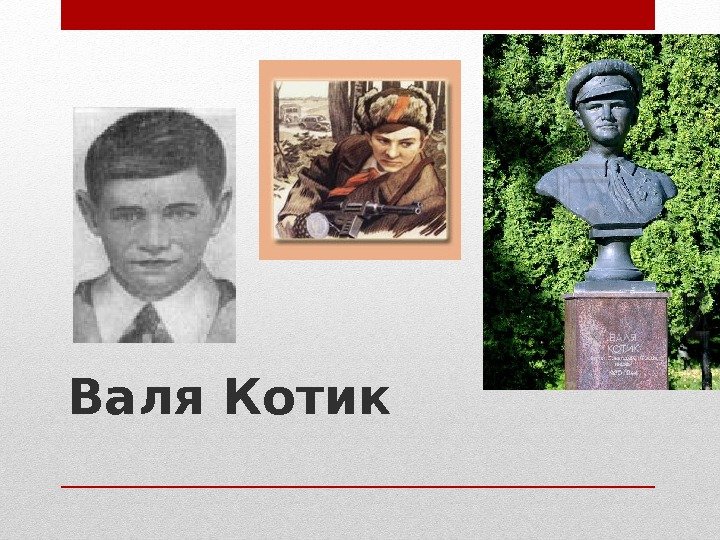
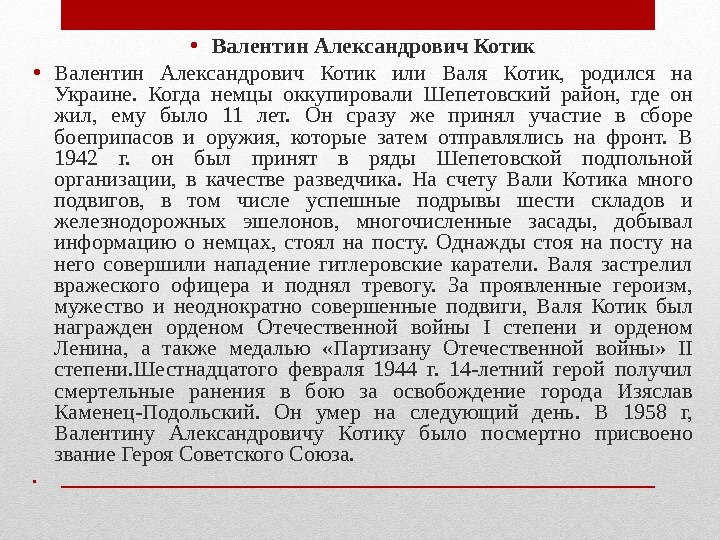 Valentin Alexandrovich Kotik or Valya Kotik, was born in Ukraine. When the Germans occupied the Shepetovsky district, where he lived, he was 11 years old. He immediately took part in the collection of ammunition and weapons, which were then sent to the front. In 1942, he was accepted into the ranks of the Shepetovskaya underground organization as a scout. Valya Kotik has many feats on his account, including the successful blowing up of six warehouses and railway echelons, numerous ambushes, obtaining information about the Germans, and standing at the post. Once, while standing at his post, he was attacked by Nazi punishers. Valya shot an enemy officer and raised the alarm. For his heroism, courage and repeatedly accomplished feats, Valya Kotik was awarded the Order of the Patriotic War of the 1st degree and the Order of Lenin, as well as the medal "Partisan of the Patriotic War" of the 2nd degree. February 16, 1944 14 -year hero was mortally wounded in the battle for the liberation of the city of Izyaslav Kamenetz-Podolsky. He died the next day. In 1958, Valentin Alexandrovich Kotik was posthumously awarded the title of Hero of the Soviet Union.
Valentin Alexandrovich Kotik or Valya Kotik, was born in Ukraine. When the Germans occupied the Shepetovsky district, where he lived, he was 11 years old. He immediately took part in the collection of ammunition and weapons, which were then sent to the front. In 1942, he was accepted into the ranks of the Shepetovskaya underground organization as a scout. Valya Kotik has many feats on his account, including the successful blowing up of six warehouses and railway echelons, numerous ambushes, obtaining information about the Germans, and standing at the post. Once, while standing at his post, he was attacked by Nazi punishers. Valya shot an enemy officer and raised the alarm. For his heroism, courage and repeatedly accomplished feats, Valya Kotik was awarded the Order of the Patriotic War of the 1st degree and the Order of Lenin, as well as the medal "Partisan of the Patriotic War" of the 2nd degree. February 16, 1944 14 -year hero was mortally wounded in the battle for the liberation of the city of Izyaslav Kamenetz-Podolsky. He died the next day. In 1958, Valentin Alexandrovich Kotik was posthumously awarded the title of Hero of the Soviet Union.
 Medal to the Partisan of the Patriotic War II degree Hero of the Soviet Union (Posthumously). Order of Lenin Order of the Patriotic War, 1st class
Medal to the Partisan of the Patriotic War II degree Hero of the Soviet Union (Posthumously). Order of Lenin Order of the Patriotic War, 1st class
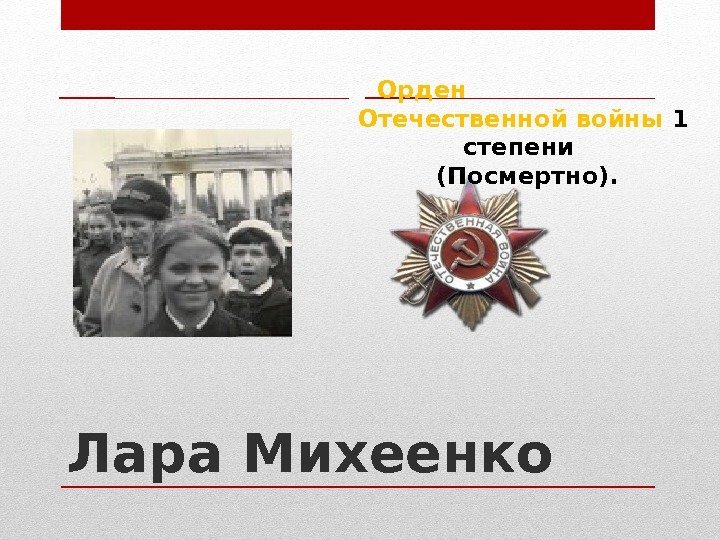
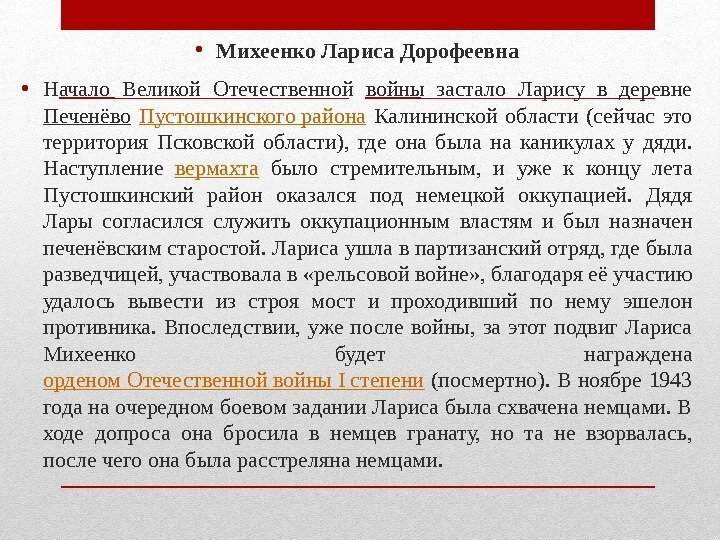 Mikheenko Larisa Dorofeevna The beginning of World War II found Larisa in the village of Pechenevo, Pustoshkinsky district, Kalinin region (now it is the territory of the Pskov region), where she was on vacation with her uncle. The offensive of the Wehrmacht was swift, and by the end of the summer the Pustoshkinsky district was under German occupation. Lara's uncle agreed to serve the occupying authorities and was appointed headman of Pechenev. Larisa went to the partisan detachment, where she was a scout, participated in " rail war”, Thanks to her participation, it was possible to disable the bridge and the enemy echelon passing through it. Subsequently, after the war, for this feat Larisa Mikheenko will be awarded the Order of the Patriotic War, I degree (posthumously). In November 1943, on the next combat mission, Larisa was captured by the Germans. During the interrogation, she threw a grenade at the Germans, but it did not explode, after which she was shot by the Germans.
Mikheenko Larisa Dorofeevna The beginning of World War II found Larisa in the village of Pechenevo, Pustoshkinsky district, Kalinin region (now it is the territory of the Pskov region), where she was on vacation with her uncle. The offensive of the Wehrmacht was swift, and by the end of the summer the Pustoshkinsky district was under German occupation. Lara's uncle agreed to serve the occupying authorities and was appointed headman of Pechenev. Larisa went to the partisan detachment, where she was a scout, participated in " rail war”, Thanks to her participation, it was possible to disable the bridge and the enemy echelon passing through it. Subsequently, after the war, for this feat Larisa Mikheenko will be awarded the Order of the Patriotic War, I degree (posthumously). In November 1943, on the next combat mission, Larisa was captured by the Germans. During the interrogation, she threw a grenade at the Germans, but it did not explode, after which she was shot by the Germans.

 Sasha Borodulin In 1941, the Germans occupied Sasha's native village in the Leningrad Region. Once a German soldier beat a woman on the street. After Nemets left, Sasha helped the woman up and led her home. Then he tracked down this fascist, unexpectedly hit him on the head with a stick. He lost consciousness and fell. Sasha took a rifle and two grenades from the German and fled into the forest. So he began his war with the Nazis. On a forest road, he killed a fascist riding a motorcycle and took his machine gun from him. There he met partisans and joined their detachment. Day after day he conducted reconnaissance, carried out very dangerous tasks, destroyed a lot of German vehicles and soldiers. For the performance of dangerous tasks, for the courage, resourcefulness and courage shown, Sasha Borodulin was awarded the Order of the Red Banner in the winter of 1941. Covering the withdrawal of a detachment of partisans, he ran out of ammunition and at the moment when he was surrounded by 10 Nazis, Sasha blew them up with him.
Sasha Borodulin In 1941, the Germans occupied Sasha's native village in the Leningrad Region. Once a German soldier beat a woman on the street. After Nemets left, Sasha helped the woman up and led her home. Then he tracked down this fascist, unexpectedly hit him on the head with a stick. He lost consciousness and fell. Sasha took a rifle and two grenades from the German and fled into the forest. So he began his war with the Nazis. On a forest road, he killed a fascist riding a motorcycle and took his machine gun from him. There he met partisans and joined their detachment. Day after day he conducted reconnaissance, carried out very dangerous tasks, destroyed a lot of German vehicles and soldiers. For the performance of dangerous tasks, for the courage, resourcefulness and courage shown, Sasha Borodulin was awarded the Order of the Red Banner in the winter of 1941. Covering the withdrawal of a detachment of partisans, he ran out of ammunition and at the moment when he was surrounded by 10 Nazis, Sasha blew them up with him.
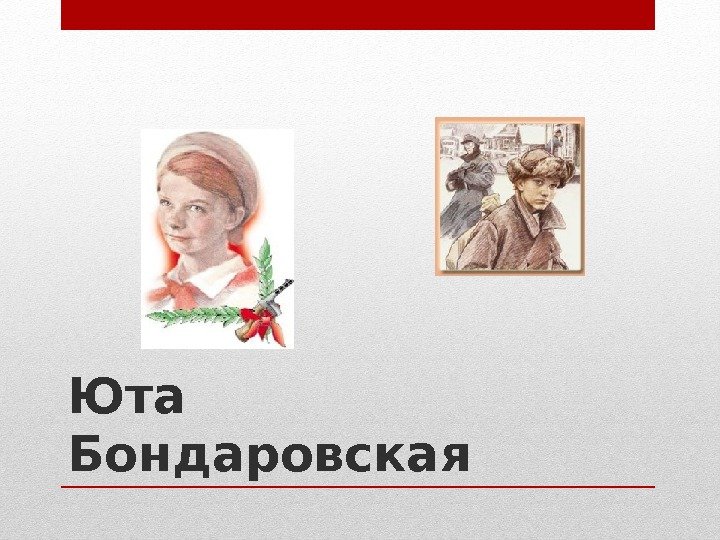
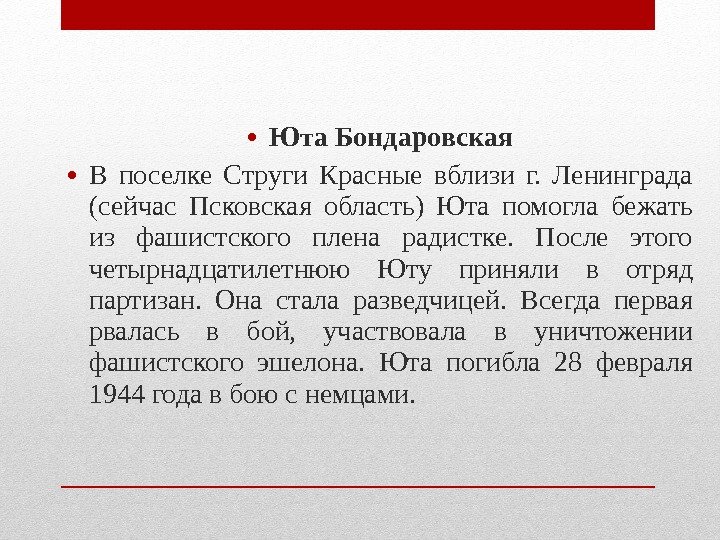 Utah Bondarovskaya In the village of Strugi Krasnye near Leningrad (now the Pskov region), Utah helped a radio operator escape from fascist captivity. After that, the fourteen-year-old Yuta was accepted into the partisan detachment. She became a spy. Always the first to fight, participated in the destruction of the fascist echelon. Utah died on February 28, 1944 in battle with the Germans.
Utah Bondarovskaya In the village of Strugi Krasnye near Leningrad (now the Pskov region), Utah helped a radio operator escape from fascist captivity. After that, the fourteen-year-old Yuta was accepted into the partisan detachment. She became a spy. Always the first to fight, participated in the destruction of the fascist echelon. Utah died on February 28, 1944 in battle with the Germans.


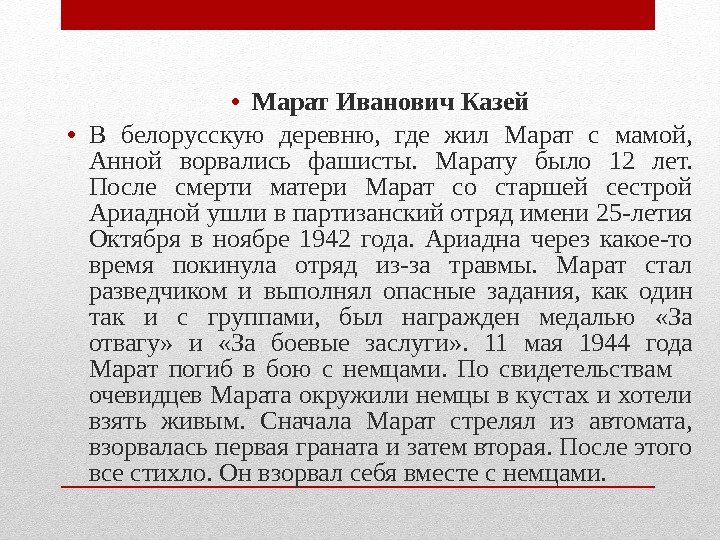 Marat Ivanovich Kazei The Nazis broke into the Belarusian village where Marat lived with his mother, Anna. Marat was 12 years old. After the death of his mother, Marat and his older sister Ariadna went to the partisan detachment named after the 25th anniversary of October in November 1942. Ariadne left the squad after some time due to injury. Marat became a scout and performed dangerous missions, both alone and with groups, was awarded the medal "For Courage" and "For Military Merit". May 11, 1944 Marat died in battle with the Germans. According to eyewitnesses, the Germans surrounded Marat in the bushes and wanted to take him alive. First, Marat fired from a machine gun, the first grenade exploded and then the second. After that, everything was quiet. He blew himself up along with the Germans.
Marat Ivanovich Kazei The Nazis broke into the Belarusian village where Marat lived with his mother, Anna. Marat was 12 years old. After the death of his mother, Marat and his older sister Ariadna went to the partisan detachment named after the 25th anniversary of October in November 1942. Ariadne left the squad after some time due to injury. Marat became a scout and performed dangerous missions, both alone and with groups, was awarded the medal "For Courage" and "For Military Merit". May 11, 1944 Marat died in battle with the Germans. According to eyewitnesses, the Germans surrounded Marat in the bushes and wanted to take him alive. First, Marat fired from a machine gun, the first grenade exploded and then the second. After that, everything was quiet. He blew himself up along with the Germans.
 Order of Lenin Order of the Patriotic War, 1st class Medal "For Military Merit" Hero of the Soviet Union (Posthumously). Medal of Honor"
Order of Lenin Order of the Patriotic War, 1st class Medal "For Military Merit" Hero of the Soviet Union (Posthumously). Medal of Honor"

 Golikov Leonid Alexandrovich Lenya Golikov - partisan reconnaissance 67th partisan detachment of the 4th Leningrad partisan brigade, operating on the territory of the temporarily occupied Novgorod and Pskov regions. Lenya repeatedly penetrated the Nazi garrisons, collecting data on the enemy. With his direct participation, 2 railway and 12 highway bridges were blown up, 2 food and feed depots and 10 vehicles with ammunition were burned. He especially distinguished himself in the defeat of enemy garrisons in the villages of Aprosovo, Sosnitsy, Sever. Accompanied a wagon train with food in 250 carts to besieged Leningrad. On January 24, 1943, a 16-year-old partisan died a heroic death in a battle near the village of Ostraya Luka, Dedovichsky District, Pskov Region.
Golikov Leonid Alexandrovich Lenya Golikov - partisan reconnaissance 67th partisan detachment of the 4th Leningrad partisan brigade, operating on the territory of the temporarily occupied Novgorod and Pskov regions. Lenya repeatedly penetrated the Nazi garrisons, collecting data on the enemy. With his direct participation, 2 railway and 12 highway bridges were blown up, 2 food and feed depots and 10 vehicles with ammunition were burned. He especially distinguished himself in the defeat of enemy garrisons in the villages of Aprosovo, Sosnitsy, Sever. Accompanied a wagon train with food in 250 carts to besieged Leningrad. On January 24, 1943, a 16-year-old partisan died a heroic death in a battle near the village of Ostraya Luka, Dedovichsky District, Pskov Region.


 Valery Volkov Volkov Valery was born in 1929. During the evacuation to the war, Valera's class came under fire. Before his eyes, teachers and classmates died. After what he saw, the boy decided to get to the military unit in order to fight the enemy together with adults. Since almost everything was destroyed, the Red Army soldiers leave the boy at home, and he becomes the "son of the regiment." At the front, he brought ammunition to the guns and helped in urgent matters. In especially difficult moments, he fought off fascist attacks with weapons in his hands. Due to his small stature, he often found himself with scouts, mined various important information. By the beginning of the summer of 1942 Valery Volkov was fighting in Sevastopol. During the German offensive, he rushed to the going tank and destroyed it with a bunch of grenades, after which he died a heroic death.
Valery Volkov Volkov Valery was born in 1929. During the evacuation to the war, Valera's class came under fire. Before his eyes, teachers and classmates died. After what he saw, the boy decided to get to the military unit in order to fight the enemy together with adults. Since almost everything was destroyed, the Red Army soldiers leave the boy at home, and he becomes the "son of the regiment." At the front, he brought ammunition to the guns and helped in urgent matters. In especially difficult moments, he fought off fascist attacks with weapons in his hands. Due to his small stature, he often found himself with scouts, mined various important information. By the beginning of the summer of 1942 Valery Volkov was fighting in Sevastopol. During the German offensive, he rushed to the going tank and destroyed it with a bunch of grenades, after which he died a heroic death.


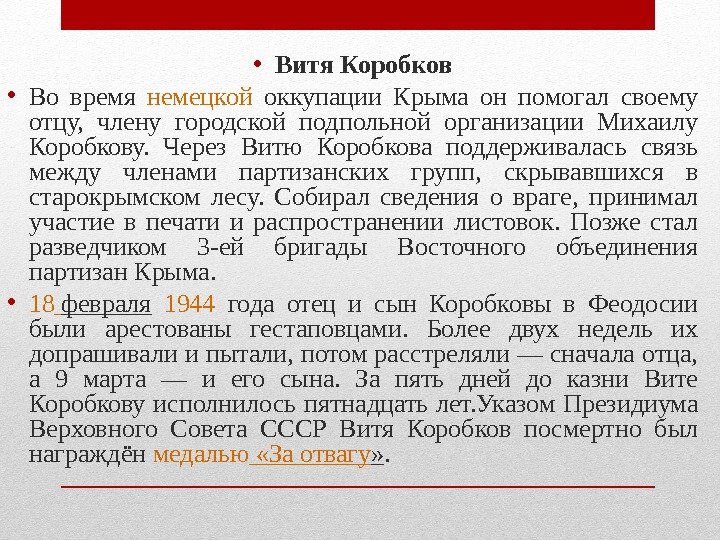 Vitya Korobkov During the German occupation of Crimea, he helped his father, a member of the city's underground organization, Mikhail Korobkov. Through Vitya Korobkov, communication was maintained between members of partisan groups hiding in the Starokrymsk forest. He collected information about the enemy, took part in the printing and distribution of leaflets. Later he became a scout of the 3rd brigade of the Eastern Association of Partisans of Crimea. On February 18, 1944, the father and son of the Korobkovs in Feodosia were arrested by the Gestapo. For more than two weeks they were interrogated and tortured, then shot - first by the father, and on March 9 - and his son. Five days before the execution, Vita Korobkov turned fifteen. By decree of the Presidium of the Supreme Soviet of the USSR, Vitya Korobkov was posthumously awarded the medal "For Courage".
Vitya Korobkov During the German occupation of Crimea, he helped his father, a member of the city's underground organization, Mikhail Korobkov. Through Vitya Korobkov, communication was maintained between members of partisan groups hiding in the Starokrymsk forest. He collected information about the enemy, took part in the printing and distribution of leaflets. Later he became a scout of the 3rd brigade of the Eastern Association of Partisans of Crimea. On February 18, 1944, the father and son of the Korobkovs in Feodosia were arrested by the Gestapo. For more than two weeks they were interrogated and tortured, then shot - first by the father, and on March 9 - and his son. Five days before the execution, Vita Korobkov turned fifteen. By decree of the Presidium of the Supreme Soviet of the USSR, Vitya Korobkov was posthumously awarded the medal "For Courage".
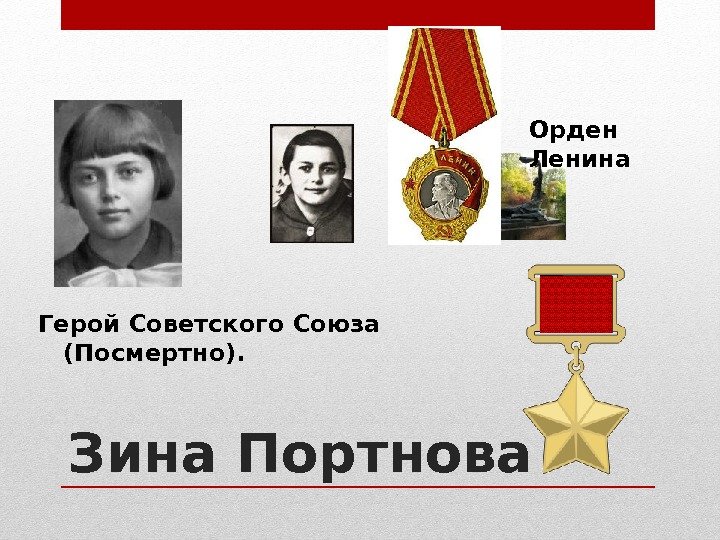
 Zina Portnova Born in Leningrad in 1926. In June 1941, the parents sent the girl to the village of Zui (Vitebsk region) for school break. Just at that time, the Nazis invaded the USSR, and Portnova ended up in the occupied territory. She was not going to put up with the current state of affairs and decided to fight the enemy. She was a member of the youth underground group "Young Avengers", fought against the fascist invaders, never retreated and looked at new challenges with a challenge. Even in the most Hard times the girl never cared about herself, but was more worried about others. During the execution of the next task, she was captured by the Nazis and executed in January 1944.
Zina Portnova Born in Leningrad in 1926. In June 1941, the parents sent the girl to the village of Zui (Vitebsk region) for school break. Just at that time, the Nazis invaded the USSR, and Portnova ended up in the occupied territory. She was not going to put up with the current state of affairs and decided to fight the enemy. She was a member of the youth underground group "Young Avengers", fought against the fascist invaders, never retreated and looked at new challenges with a challenge. Even in the most Hard times the girl never cared about herself, but was more worried about others. During the execution of the next task, she was captured by the Nazis and executed in January 1944.

